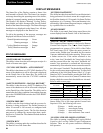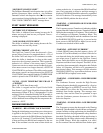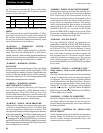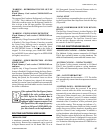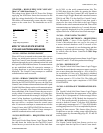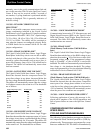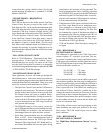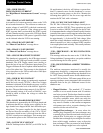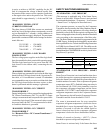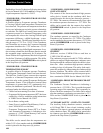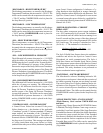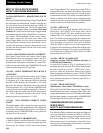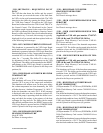
YORK INTERNATIONAL
102
FORM 160.55-O1 (604)
Hz applications), the drive will initiate a system shut-
down. A common cause for this shutdown is a severe
sag in the incoming power to the drive. Monitor the
in com ing three-phase AC line for severe sags and also
monitor the DC link with a voltmeter.
“VSD – DC BUS VOLTAGE IMBALANCE”
The DC link is Þ ltered by many large electrolytic ca-
pac i tors, rated for 450VDC. These capacitors are wired
in series to achieve 900VDC capability for the DC link.
It is important that the voltage be shared equally from the
junction of the center or series capacitor con nec tion, to the
negative bus and the positive bus. This cen ter point should
be ap prox i mate ly ½ of the total DC link voltage. Most
actual bus voltage imbalance con di tions are caused by a
shorted capacitor or a leaky or shorted IGBT tran sis tor
in an output phase bank as sem bly. This usually in di cates
the VSD requires ser vice.
“VSD – PRECHARGE – DC BUS VOLTAGE IM-
BAL ANCE”
This message indicates the same as the “VSD-DC Bus
Voltage imbalance” message above, except the con di tion
occurred during the Pre-lube period.
“VSD – HIGH INTERNAL AMBIENT TEM PER A-
TURE”
The ambient temperature monitored is actually the
tem per a ture detected by a component mounted on the
VSD logic board. The high ambient trip threshold is set
for 140°F. Some potential causes for this shutdown are:
in ter nal VSD fan failure, VSD water pump failure or an
entering condenser water temperature that exceeds the
allowable limit for the job. Additional causes for the
shutdown are:
• Plugged Strainer – The standard 1.5” Y-strain er
con tains a woven mesh element with 20 stain less
steel wires per inch. This has been found to work ad-
e quate ly on most ap pli ca tions. Some users may have
very dirty condenser water, which can cause the
strainer to plug. Lo ca tions with special con di tions
may want to consider a dual strainer ar range ment
with quar ter turn valves, to permit cleaning of one
strain er with the unit still on line.
• Plugged Heat-exchanger – In cases where the
strain er plugs frequently, the heat-exchanger may
even tu al ly plug or become restricted to the point of
re duced ß ow. At this point, we sug gest you back-
ß ush the heat-exchanger by re vers ing the two rub ber
hoses which supply condenser water to-from the
heat-exchanger. If the rust cannot be back-ß ushed,
the heat-exchanger might have to be re placed.
“VSD – HIGH PHASE C
INSTANTANEOUS CURRENT”
See “High Phase A Instantaneous Current” mes sage
above.
“VSD – PHASE A GATE DRIVER”
A second level of current protection exists on the VSD
driver boards themselves. The collector-to-emitter sat-
u ra tion voltage of each IGBT is checked con tin u ous ly
while the device is gated on. If the voltage across the
IGBT is greater than a set threshold, the IGBT is gated
off and a shutdown pulse is sent to the VSD logic board
shutting down the entire VSD sys tem. A gate driver fault
can be initiated when the VSD is not running.
“VSD – PHASE B GATE DRIVER”
See “Phase A Gate Driver” message above.
“VSD – PHASE C GATE DRIVER”
See “Phase A Gate Driver” message above.
“VSD – SINGLE PHASE INPUT POWER”
This shutdown is generated by the SCR trigger control
and relayed to the VSD logic board to initiate a system
shutdown. The SCR Trigger control uses circuitry to
detect the loss of any one of the three input phases. The
Trigger will detect the loss of a phase within one half line
cycle of the phase loss. This message is also dis played
every time power to the VSD is removed or if the input
power dips to a very low level.
“VSD – HIGH DC BUS VOLTAGE”
The VSD’s DC link voltage is continuously monitored
and if the level exceeds 745VDC, a Bus Over-Voltage
shutdown is initiated. If this shutdown occurs, it will be
necessary to look at the level of the 460VAC ap plied to
the drive. The speciÞ ed voltage range is 414 to 508VAC.
If the incoming voltage is in excess of 508VAC, steps
should be taken to reduce the voltage to within the
spec i Þ ed limits.
“VSD – LOGIC BOARD POWER SUPPLY”
This shutdown is generated by the VSD logic board and
it indicates that the low voltage power supplies for the
logic boards have dropped below their allowable op er -
at ing limits. The power supplies for the logic boards
are derived from the secondary of the 120 to 24VAC
trans form er, which in turn, is derived from the 480 to
120VAC control power transformer. This message usu-
al ly means the power to the VSD has been removed.
“VSD – LOW DC BUS VOLTAGE’
If the DC link drops below 500VDC (or 414VDC for 50
OptiView Control Center



